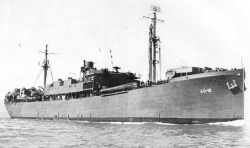Destroyer Tenders
US Navy Service and Repairs Ships of WW2
By Stephen Sherman, April, 2010. Updated February 16, 2012.
Destroyer Tenders were well-named. They did just that; they "tended," serviced, repaired, and supplied destroyers and other small ships. Destroyers were small, fast ships, jammed full of machinery and weapons, with necessarily small crews. Destroyer Tenders, like my father's ship, USS Denebola (AD-12), serviced the destroyers at sea, so the destroyers did not have to return stateside for most repairs.
In his memoirs, my father mentioned several examples of their service and repair work. When they sailed for the Mediterranean, the Denebola carried, among other things, supplies for the Hilary P. Jones (DD-427). While in convoy, a minesweeper's radio broke down, and the Denebola sent across a radio technician in a breeches buoy. The Denebola's crew included medical and dental staff, and they served the destroyer crews too. The Denny had a well-equipped machine shops, and could service the destroyers' machinery. As another example, the anti-submarine detection devices (HFDF, Huff-Duff) needed to be calibrated with another device called a "pelorus," (think of a sextant); the Denny's machine shop fabricated a pelorus for the Huff-Duff engineers.
It should be clear that destroyer tenders were not floating dry-docks; they did not replace major port facilities. Serious battle damage, complete engine overhauls, installation of new weapons, etc. had to be done in dry dock. Destroyer Tenders are less common in the present-day US Navy, largely because modern machinery and equipment is much more reliable than it was in the 1940s.
My dad also mentioned the good-natured rivalry between the destroyer, or "tin can," sailors, and the destroyer-tender crews. In any navy, larger ships are more prestigious than smaller ships, so the men on the Denebola looked down upon the "tin can sailors." On the other hand, sailors serving in combat ships, always disdain their non-combatant support services. Thus, the destroyer crews referred to the men on the Denebola as "gedunk sailors," for the well-supplied ice cream stands on board. My Dad remarked, "The guys on the destroyers always called us 'gedunk sailors,' but whenever we tied up to one, you couldn't get near the gedunk stand, because the tin can sailors were lined up eight deep."
DESTROYER TENDER NUMBERS
As of 1943 - 1945
| U.S.S. DIXIE AD-1 (1922) | U.S.S. PRARIE AD-15 |
| U.S.S. MELVILLE AD-2 | U.S.S. CASCADE AD-16 |
| U.S.S. DOBBIN AD-3 | U.S.S. PIEDMONT AD-17 |
| U.S.S. WHITNEY AD-4 | U.S.S. SIERRA AD-18 |
| U.S.S. PRAIRIE AD-5 (1923) | U.S.S. YOSEMITE AD-19 |
| U.S.S. PANTHER AD-6 (1923) | U.S.S. HAMUL AD-20 |
| U.S.S. LEONIDA5 AD-7 (1922) | U.S.S. MARKAB AD-21 |
| U.S.S. BUFFALO AD-8 (1927) | U.S.S. KLONDIKE AD-22 |
| U.S.S. BLACKHAWK AD-9 | U.S.S. ARCADIA AD-23 |
| U.S.S. BRIDGEPORT AD-10 | U.S.S. EVERGLADES AD-24 |
| U.S.S. ALTAIR AD-11 | U.S.S. FRONTIER AD-25 |
| U.S.S. DENEBOLA AD-12 | U.S.S. SHENANDOAH AD-26 |
| U.S.S. RIEGEL AD-13* | U.S.S. YELLOWSTONE AD-27 |
| U.S.S. DIXIE AD-14 | U.S.S. GRAND CANYON AD-28 |
| U.S.S. Isle Royale AD-29 | U.S.S. SAMUEL GOMPERS AD-37 |
| AD-30 (cancelled) | U.S.S. PUGET SOUND AD-38 |
| U.S.S. TIDEWATER AD-31 | U.S.S. YELLOWSTONE AD-41 |
| AD-32 | U.S.S. ACADIA AD-42 |
| AD-33 | U.S.S. CAPE COD AD-43 |
| U.S.S. ALCOR AD-34 | U.S.S. SHENANDOAH AD-44 |
| AD-35 | |
| U.S.S. BRYCE CANYON AD-36 |
* U.S.S. RIEGEL HULL CHANGED TO AR-11
Sources:
Ships and aircraft of the U.S. Fleet. Fahey's Victory Edition Copyright 1945. Reprinted 1976 - U.S. Naval Institute Press.
Memoirs of Milton W. Sherman (1919-2010). He served in the U.S. Navy during WW2, on board the USS Denebola, AD-12, when he was in mid-twenties. On board the Denebola, he spent many happy hours in Casco Bay, Maine, where this event took place. You might enjoy reading a fuller version of his travels in the Denebola.

